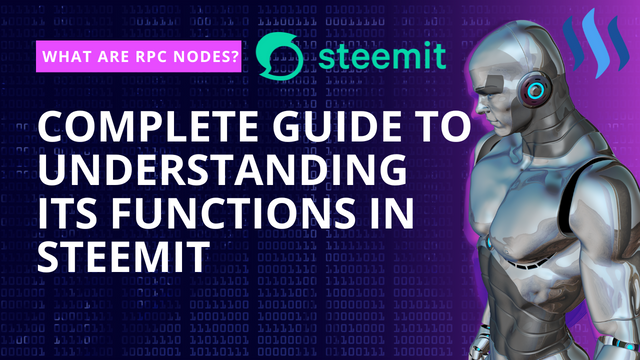What are RPC Nodes? Complete Guide to Understanding its Functions in Steemit

RPC Node (Remote Procedure Call Node) on Steemit is a vital component in the Steem blockchain ecosystem. RPC Node acts as a bridge between users or applications and the Steem blockchain network. Here is a detailed explanation of RPC Node and its role in Steemit:
What are RPC Nodes?
General Definition:
- Remote Procedure Call (RPC): RPC is a mechanism that allows applications to communicate with servers or other nodes on a network, as if they were calling local functions. In the context of blockchain, RPC allows applications and users to interact with the blockchain through structured requests and responses.
RPC Nodes in Steemit:
- Node: In the context of blockchain, a node is a computer or server that participates in a blockchain network by processing transactions and maintaining a copy of the blockchain ledger.
- RPC Node: Is a special node that provides an interface for making remote procedure calls (RPC) to the Steem blockchain. It allows applications and users to interact with the blockchain, send transactions, or obtain data from the blockchain.
Fungsi RPC Node pada Steemit
Interaction with Blockchain:
- Data Requests: RPC Nodes allow applications to query data from the blockchain, such as account information, transaction history, or block status.
- Transaction Submission: Users and applications can submit transactions to the blockchain via RPC Nodes, including new posts, votes, or token transfers.
Accessing the API:
- API Endpoints: ** RPC Node provides API endpoints that applications can access to interact with the blockchain. This API provides various functions, such as getting information about posts, checking account balances, or posting new content.
Improve Performance and Scalability:
- Performance: RPC Nodes can improve performance by processing requests and responses efficiently, allowing applications to interact with the blockchain quickly.
- Scalability: By providing separate interfaces for requests and responses, RPC Nodes help keep blockchain networks efficient and responsive.
Why Choose a Good RPC Node?
Reliability and Stability:
- Stable Connection: Choosing a stable and reliable RPC Node is important to ensure that your application can interact with the blockchain without interruption.
- Minimal Downtime: Reliable nodes will have minimal downtime, ensuring consistent access to blockchain data and services.
Speed and Performance:
- Fast Response: High-performance nodes will provide fast responses to API requests, improving user experience.
- Transaction Processing: Efficient nodes will process transactions quickly and accurately, which is important for applications that require real-time processing.
Security:
- Data Integrity: Choosing a secure node helps ensure that the data you receive and send is not subject to manipulation or errors.
- Protection Against Attacks: A good node should have protection against potential attacks and security threats.
How to Choose a Good RPC Node for Steemit
Reputation and Reviews:
- Reputation Check: Choose an RPC Node that has a good reputation in the Steemit or blockchain community.
- User Reviews: Look for reviews from other users to get an idea of the node's reliability and performance.
Features and Support:
- API Features: Make sure node provides the API features you need for your application.
- Technical Support: Choose a node that offers good technical support if you run into problems or need help.
Fees and Access:
- Costs: Check if there are any costs associated with using RPC Node and make sure they fit within your budget.
- Access: Make sure the node provides the access you need to interact with the blockchain.
RPC Nodes play a crucial role in ensuring that applications and users can interact with the Steem blockchain efficiently and effectively. Choosing the right RPC Node can help improve the performance and reliability of your application.
This article succeeds in explaining the function and role of RPC nodes in Steemit in a very clear and structured way